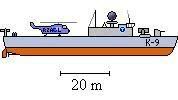Community Vessel Corvette
| CDF Naval Service Community Vessel | ||||||||||||
|---|---|---|---|---|---|---|---|---|---|---|---|---|
| ||||||||||||
|
| ||||||||||||
Corvettes are the smallest surface ships in the CDF Naval Service of Sober Thought. They are dedicated to anti-submarine warfare, whether escorting merchant ships, escorting naval ships or conducting anti-submarine sweeps. They pack nearly as much anti-submarine punch as a frigate with about a third of the crew. Except for a few test and training boats, the Community Defence Forces do not build corvettes in peacetime.
In wartime, these inexpensive but effective ocean going vessels can be mass produced numbers using assembly line and modular construction techniques. Smaller shipyards can manufacture 14-metre sections, five of which are fitted together to form a single hull. The superstructure is identical to that of the patrol boat and the gun turret the same size the equivalent on the cruiser-helicopter carrier. Corvettes bear hull numbers in the K series, e.g., K-2, K-9, K-67, and lack official names.
Serving sailors, recent naval veterans and new recruits chosen for their civilian experience as mariners each make up roughly a third of the 65-person crew. Most of the crew ranking Leading Sailor and above are detached from destroyers, frigates or patrol boats. Some naval veterans or conscripted civilian mariners rise to Vice Warrant Officer rank and above, a few even becoming captains.
The Bridge Section has three officers who alternate as officer of the watch: a Lieutenant acting as commanding officer, a Vice Lieutenant as weapons officer and executive officer, and a Vice Lieutenant as engineering officer. The other ranks in the section are a Vice Warrant Officer acting as boat's petty officer, two Leading Sailors, three Master Sailors and nine Sailors.
The Engineering Section, besides its commander, consists of three Leading Sailors, three Master Sailors and nine Sailors. For lack of any more obvious alternative, the Sailor cook and Sailor medic report to the chief engineer.
The Naval Weapons Section consists, besides its commander, of thirty all ranks: 5 Leading Sailors, 5 Master Sailors and 20 Sailors. They operate five weapons systems, in declining order of importance for anti-submarine warfare:
- One pair of subsurface missile launchers armed with 48 missiles, stern
- Two torpedo tubes armed with a dozen torpedoes, one on each side of the bow and fore the superstructure
- Two pairs of submarine mortars with 60 depth charges and 40 mini-mines, one pair on each side of the stern
- One twin surface missile launchers armed with 36 missiles, fore of the superstructure
- One anti-aircraft/anti-surface turret with twin 20 mm guns, aft of the bow.
Air component
The corvette carries a single HUBR-77 Hubert ASW naval helicopter on the flight deck aft of the superstructure. When airborne, the helicopter lowers its subsurface sensors by winched cable into the sea. If it senses a submarine, it can fire one or both of its left- and right-facing anti-submarine missile launchers.
The air detachment consists of ten all ranks: a Vice Lieutenant pilot and commanding officer, a Vice Lieutenant co-pilot and executive officer, a Leading Flier head mechanic, a Master Flier crew chief and sensor technician, a Master Flier ordnance technician, two Flier weapons technicians and three Flier mechanics.

